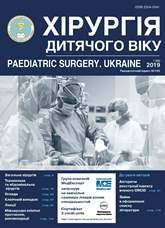Using mathematical modeling in the differential diagnosis of acute abdominal syndrome in children
DOI:
https://doi.org/10.15574/PS.2019.62.47Keywords:
mathematical modeling, diagnostics, acute abdominal syndrome, childrenAbstract
The choice of the most perfect method for differential diagnosis of abdominal syndrome in children is still under discussion. It is known that primary examination and physical examination are the fastest, accessible and well-informed studies of the child’s condition.
The purpose of our work was to improve the differential diagnosis of acute appendicitis and functional disorders of the digestive tract in children with acute abdominal syndrome by determining the informativeness of clinical signs and their combination by multivariate logistic regression.
Material and methods. We have carried out a retrospective analysis of the history of illnesses of 649 children, who applied for medical aid for abdominal syndrome at MI «Odessa Regional Children’s Clinical Hospital» in the period of 2014–2016 yy. One third of children (248 persons (38.2 % (95% CI 34.4–42.0)) after the examination was diagnosed with surgical pathology.
Results. As a result of mathematical modeling, it was possible to differentiate the group membership of children with abdominal syndrome according to certain features, which made it possible to quickly and easily make a diagnosis of functional and surgical pathology of the patient’s digestive system at the stage of the primary examination with a general accuracy of 93.4% and to decide on the amount of urgent treatment (at acute appendicitis) or additional examination (at irritable bowel syndrome).
Conclusions. The proposed differential diagnosis using the multivariate logistic regression method, taking into account the integrated assessment of the combination of clinical signs, greatly speeds up the diagnosis of functional intestinal pathology, suggests the presence of syntopeia and helps to decide more quickly on the scope of additional examination and therapeutic tactics by the primary care physician.
References
Karaseva OV. (2011). Acute abdominal pain in pediatric practice. Pediatric pharmacology. 8(5):21–27.
Rusak PS. (2011). Innovative technologies in diagnostics, treatment and prevention of urgent surgical abdominal pathology in children. Kyiv:32.
Rusak PS. (2015). Problem of acute abdomen in pediatrics. Zhytomyr: Polissya:167p.
Senatorova АS, Osipenko EV, Ermolaev MN. (2009). Differential diagnosis of abdominal pain in pediatric practice. Dytiachyi likar. 1 (1):29–40.
Ursova NI. (2017). Tactics of peditry in abdominal pain in children. Meditsinskij sovet. 9:80–84.
Shutova EV. (2018). Abdominal pain syndrome in children and adolescents: treatment options. Zdorov’e rebenka. 13(5):495–501. https://doi.org/10.22141/2224-0551.13.5.2018.141567
Yankovoj АG. (2001). Mnogomernyj analiz v sisteme STATISTICA. Odessa: OPTIMUM: 216.
Hijaz N, Friesen C. (2017). Managing acute abdominal pain in pediatric patients: current perspectives. Pediatric Health, Medicine And Therapeutics. 8:83–91. https://doi.org/10.2147/PHMT.S120156; PMid:29388612 PMCid:PMC5774593
Kim J. (2013). Acute Abdominal Pain in Children. Pediatric Gastroenterology, Hepatology & Nutrition. 16(4):219–224. https://doi.org/10.5223/pghn.2013.16.4.219; PMid:24511517 PMCid:PMC3915729
Kulik D, Uleryk E, Maguire J. (2013). Does this child have appendicitis? A systematic review of clinical prediction rules for children with acute abdominal pain. Journal Of Clinical Epidemiology. 66(1):95–104. https://doi.org/10.1016/j.jclinepi.2012.09.004; PMid:23177898
Downloads
Issue
Section
License
The policy of the Journal “PAEDIATRIC SURGERY. UKRAINE” is compatible with the vast majority of funders' of open access and self-archiving policies. The journal provides immediate open access route being convinced that everyone – not only scientists - can benefit from research results, and publishes articles exclusively under open access distribution, with a Creative Commons Attribution-Noncommercial 4.0 international license(СС BY-NC).
Authors transfer the copyright to the Journal “PAEDIATRIC SURGERY.UKRAINE” when the manuscript is accepted for publication. Authors declare that this manuscript has not been published nor is under simultaneous consideration for publication elsewhere. After publication, the articles become freely available on-line to the public.
Readers have the right to use, distribute, and reproduce articles in any medium, provided the articles and the journal are properly cited.
The use of published materials for commercial purposes is strongly prohibited.

